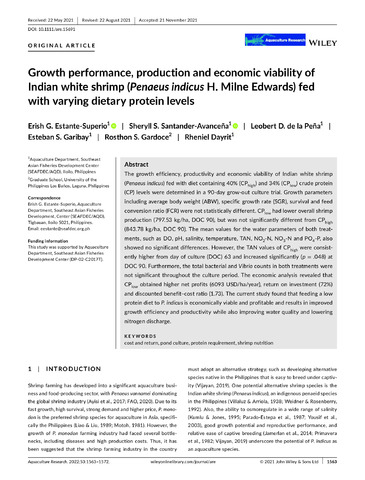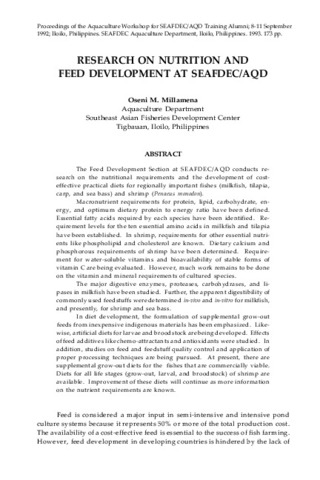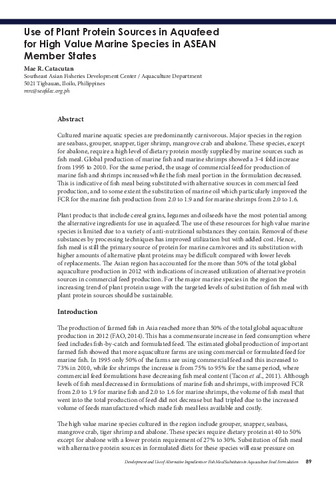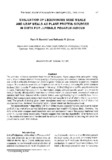Growth performance, production and economic viability of Indian white shrimp (Penaeus indicus H. Milne Edwards) fed with varying dietary protein levels
- Global styles
- MLA
- Vancouver
- Elsevier - Harvard
- APA
- Help

閲覧/開く
日付
2022-03著者
Page views
570ASFA keyword
AGROVOC keyword
Metadata
アイテムの詳細レコードを表示するCited times in Scopus
- Citations
- Scopus - Citation Indexes: 3
- Captures
- Mendeley - Readers: 11
Share
抄録
The growth efficiency, productivity and economic viability of Indian white shrimp (Penaeus indicus) fed with diet containing 40% (CPhigh) and 34% (CPlow) crude protein (CP) levels were determined in a 90-day grow-out culture trial. Growth parameters including average body weight (ABW), specific growth rate (SGR), survival and feed conversion ratio (FCR) were not statistically different. CPlow had lower overall shrimp production (797.53 kg/ha, DOC 90), but was not significantly different from CPhigh (843.78 kg/ha, DOC 90). The mean values for the water parameters of both treatments, such as DO, pH, salinity, temperature, TAN, NO2-N, NO3-N and PO4-P, also showed no significant differences. However, the TAN values of CPhigh were consistently higher from day of culture (DOC) 63 and increased significantly (p = .048) at DOC 90. Furthermore, the total bacterial and Vibrio counts in both treatments were not significant throughout the culture period. The economic analysis revealed that CPlow obtained higher net profits (6093 USD/ha/year), return on investment (72%) and discounted benefit–cost ratio (1.73). The current study found that feeding a low protein diet to P. indicus is economically viable and profitable and results in improved growth efficiency and productivity while also improving water quality and lowering nitrogen discharge.
Suggested Citation
Estante-Superio, E., Santander-Avancena, S., de la Peña, L. D., Garibay, E. S., Gardoce, R. S., & Dayrit, R. (2022). Growth performance, production and economic viability of Indian white shrimp (Penaeus indicus H. Milne Edwards) fed with varying dietary protein levels. Aquaculture Research , 53(4), 1563-1572. https://doi.org/10.1111/are.15691
Type
ArticleISSN
1355-557X; 1365-2109Collections
- Journal Articles [1249]
Related items
Showing items related by title, author, creator and subject.
-
Research on nutrition and feed development at SEAFDEC/AQD
Millamena, Oseni M. (Aquaculture Department, Southeast Asian Fisheries Development Center, 1993)The Feed Development Section at SEAFDEC/AQD conducts research on the nutritional requirements and the development of costeffective practical diets for regionally important fishes (milkfish, tilapia, carp, and sea bass) and ... -
Use of plant protein sources in aquafeed for high value marine species in ASEAN member states
Catacutan, Mae R. (Aquaculture Department, Southeast Asian Fisheries Development Center, 2015)Cultured marine aquatic species are predominantly carnivorous. Major species in the region are seabass, grouper, snapper, tiger shrimp, mangrove crab and abalone. These species, except for abalone, require a high level of ... -
Evaluation of leguminous seed meals and leaf meals as plant protein sources in diets for juvenile Penaeus indicus
Eusebio, Perla S.; Coloso, Relicardo M. (Society of Israeli Aquaculture and Marine Biotechnology, 1998)The potential of locally available legumes (white cowpea, Vigna unguiculata, and green mung-bean, Vigna radiata) and leaf meals (papaya, Carica papaya, and cassava, Manihut esculenta) in combination with defatted soybean ...






